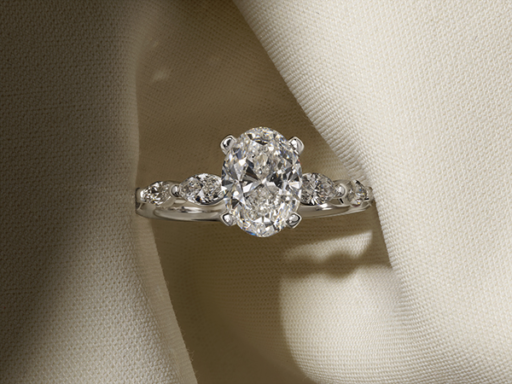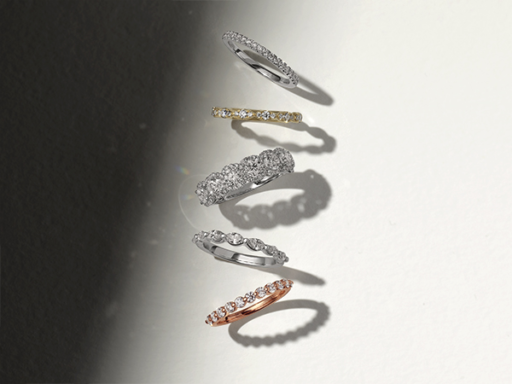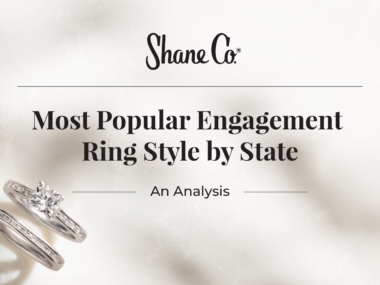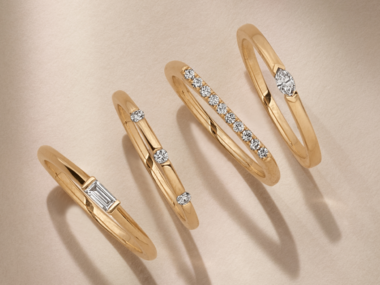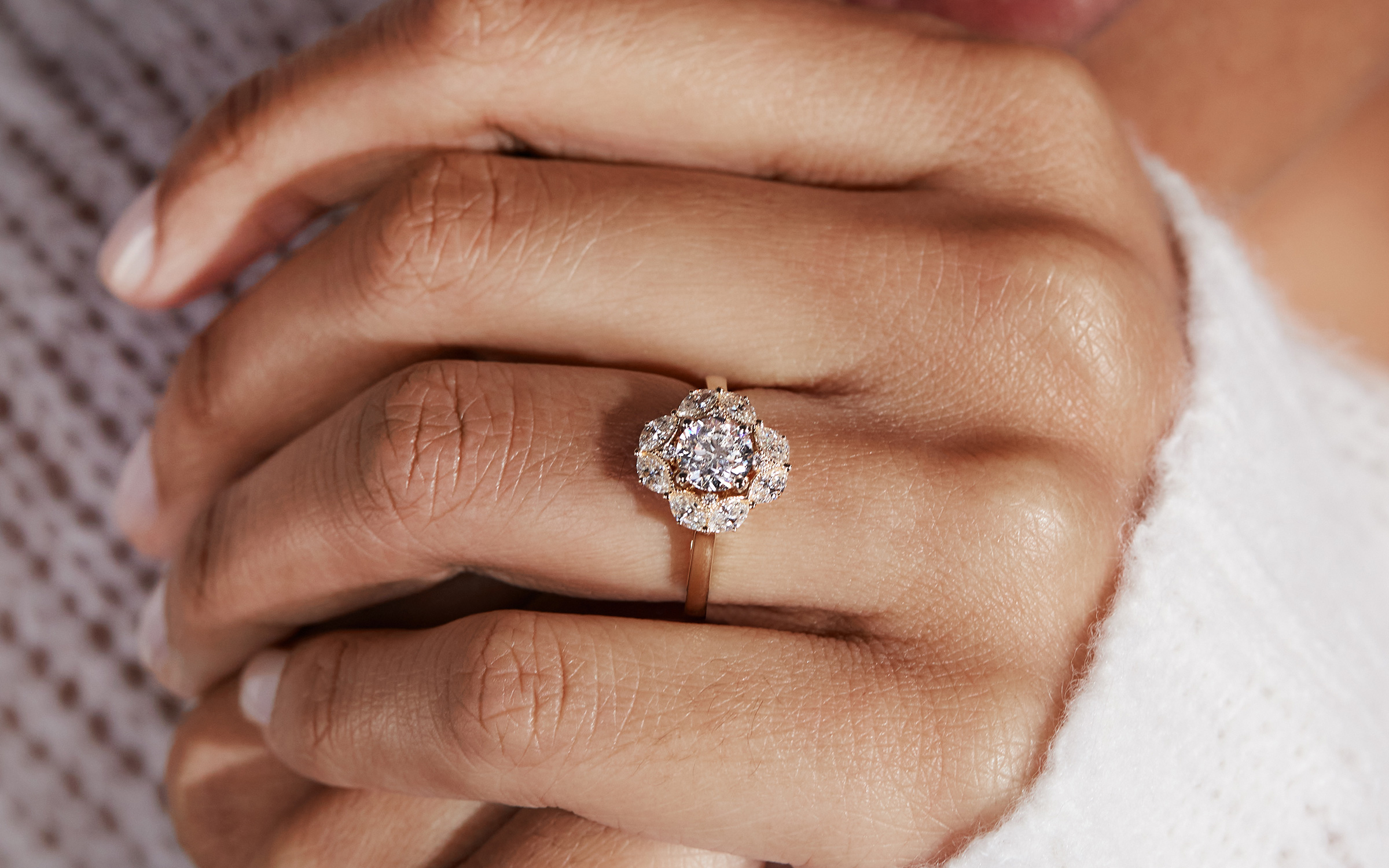The history of engagement rings is a fascinating story. Rings have long been used as symbols of commitment. In fact, ancient Romans used “betrothal” or “truth rings” to reference a committed bond between two people. These rings were usually made from twisted copper or even braided hair, but were not always associated with marriage. They could also be a sign of affection or friendship. If you’ve ever asked yourself, “What hand does an engagement ring go on?” you may be surprised to hear that the left-hand ring finger has been synonymous with commitment for a very long time. The Romans believed the third finger on your left hand was significant because it held a vein called the “vena amorous,” which ran all the way to your heart. Though this idea was later disproven, the tradition stuck.
In the second century B.C., a Roman bride-to-be might actually receive two rings — one made of iron and one made of gold. This early incarnation of engagement rings for women was split into two for a reason: the gold ring was worn in public, while the iron one was worn at home while taking care of household duties.
In 1215, Pope Innocent III declared there should be a waiting period between when a couple announces they want to be married and the actual wedding, so the ring was chosen to be used as a symbol of commitment in the interim. These antique engagement rings probably looked quite different from what we envision today — more than likely, they were simple metal bands that commemorated the couple’s promise to marry.
Where do diamonds fit in?
The first documented use of a diamond engagement ring occurred in 1477. Archduke Maximilian of Austria proposed to Mary of Burgundy using a diamond ring adorned with stones in the shape of an “M” (for Mary, of course).
The popularization of diamond engagement rings in the history of engagement rings was mostly due to the need for a new, strong symbol of love and commitment. After World War I, engagement rings became too much of a luxury item for the everyday bride and groom. In 1947, De Beers and a well-known advertising agency called N.W. Ayer teamed up to coin the phrase “A diamond is forever.” The 4 Cs were also popularized, giving the average consumer more education and decision-making power. They now had a set of guidelines that confirmed the value of their investment. With these changes, engagement ring purchases, and specifically those with a center diamond stone, quickly began to increase.
Today, about four out of every five engagement rings sold contains a diamond. With a variety of diamond shapes to choose from, it’s now relatively easy to find loose diamonds to create what we envision as the classic engagement ring.
Rising trend: men’s engagement rings
In countries outside of the United States and Canada, it’s quite common for both women and men to wear engagement rings. Usually, a “mangagement ring” comes as a plain band of high-quality gold or silver. It may eventually serve as a wedding ring, and be replaced or moved to the right hand upon completion of the nuptials. In Argentina, for example, the groom and bride-to-be wear silver bands on their left hands while engaged, then replace the bands with the wedding rings when the ceremony takes place.
With a greater push for gender equality in recent years, the tradition of men wearing engagement rings has started to pop up more often. Check out Shane Co.’s collection of men’s rings if you’re interested in exploring this new trend.
The Claddagh ring
Other countries have different engagement ring history, or traditions surrounding engagement and wedding rings. For example the Irish Claddagh ring. The Claddagh features two hands holding a heart with a crown brandished on top. The heart is said to represent love, with the hands representing friendship and the crown representing loyalty. Tracing back to Roman times, this ring belongs to a group of European rings called “fede rings,” derived from a phrase meaning “hands joined in faith.”
There are a number of legends surrounding the origin of the Claddagh ring, the most popular of which being that it originated in the small fishing village of Claddagh in Galway, Ireland. One legend is that a silversmith named Richard Joyce was captured and enslaved in 1675 while on a boat headed to the West Indies. He was then sold into slavery to a goldsmith, who soon taught him the craft. When he was finally released 14 years later, he brought along a ring that he had created while in captivity: what we know today as the Claddagh. He presented it to his love, they married, and he ended up becoming a successful goldsmith in Galway.
Like the engagement ring, the Claddagh ring also tells a story of the wearer’s relationship status. If it’s on the right hand with the heart pointing toward the wrist, the wearer is not looking for a relationship. If it’s on the right hand with the heart pointing toward the fingertips, the wearer is single and open to love. Wearing it on the left hand with the heart pointing toward the fingertips signifies an engagement, while wearing it on the left hand with the heart pointing toward the wrist signifies a marriage.

Did you know?
Among other weird engagement traditions stands the leap-year superstitions. For some reason, countries all over the world have strange ideas about getting engaged during a leap year, including:
- In Scotland, legend insists that Queen Margaret created a law in 1288 that allowed women to propose on Leap Day, but only if they wore a red petticoat under their skirt to warn their potential fiancé that they planned to ask for marriage.
- Women are encouraged to propose on February 29 in Ireland for good luck.
- In Greece, there’s a dangerous superstition regarding getting married during a leap year. Supposedly, embracing this tradition means the relationship will end in divorce.
- In Finland, women are advised to propose on February 29. If your significant other says no, he’s required to pay you a “fine” of enough fabric to make a skirt.
These leap-year-related myths go hand in hand with women-centric traditions like the Sadie Hawkins Dance. We say that it’s never the wrong time to pop the question — and just because you’re a woman it doesn’t mean you can’t propose to your one and only!
What is a promise ring?
A promise ring, also referred to as a pre-engagement ring, symbolizes a bond or “promise” of commitment between two people. It can allude to an engagement at a later date or simply confirm a couple’s love and devotion that’s visible to the outside world. It’s a little like giving someone your class pin in high school — it allows for a visual symbol of the relationship, rather than just an internal commitment. Promise rings have become more popular in recent years due to the growing trend of couples marrying later than previous generations. If you’re not ready to commit to an engagement or not financially able to provide an engagement ring, a promise ring can be a great way to show your partner just how much they mean to you.
The idea of promise rings may actually date back to 16th-century England, where “posy rings” were engraved with romantic poems to demonstrate one’s love. In Georgian and Victorian eras, popular “acrostic rings” would spell out a promise-like word in gemstones.
If you’ve heard of promise rings, you probably remember the Jonas Brothers’ famous use of them in 2008 as a promise to stay “pure” until marriage. While the terminology seems to have gotten confused, this use would be considered a “purity ring” instead of a promise ring.
The coolest part about a promise ring is that you have much more variation in style than with an engagement ring. You can try an infinity or heart design, a cluster of stones, a Claddagh ring and more. Usually, it’s worn on the left-hand ring finger, then moved over to the right when an engagement ring is given. Shane Co. has a wide selection of stunning designs that can be given as promise rings.
Engagement ring vs. wedding ring
With all these rings and traditions to choose from, it can be difficult to tell them apart. So what are the essential differences between an engagement ring and a wedding ring?
The main thing to remember is that engagement and wedding rings traditionally come as two separate bands. The engagement ring is given, usually to the woman, as a symbol of an intent to marry, while the wedding ring is presented to both members of the couple during the wedding ceremony. This ring is placed on one’s finger by one’s significant other as a symbol of commitment and “belonging.” Sometimes, you’ll see a wedding and engagement band that are bonded together, but this is less common than the use of individual rings. After both rings are presented, the wedding band is traditionally worn on the inside, closest to the wearer’s heart.
Ultimately, how you decide to wear your rings and what they look like are entirely up to you. Keep in mind your own personal and financial preferences. While there are a lot of traditions associated with engagement rings and the history of engagement rings, the most important one is finding something that’s meaningful to you and your partner.
As a family-owned and operated business for four generations, Shane Co. understands the sentimental value that’s passed along with an engagement ring. We source our diamonds directly and ethically, hand-picking each stone for its exceptional sparkle and beauty. Our ring settings come in a tremendous variety of styles that are made to fit every budget, as well as a Free Lifetime Warranty. To create the perfect custom engagement ring, you can browse our wide selection here.

